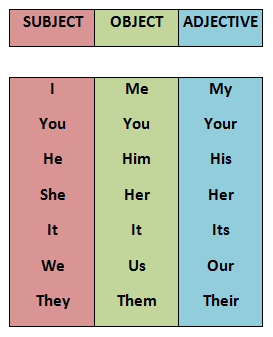Pronouns
8. Kegiatan Pembelajaran
Kegiatan Pembelajaran
1. tujuan
-
Mengidentifikasi makna, tujuan komunikasi, struktur teks, dan unsur bahasa yang terdapat dalam teks interaksi transaksional lisan dan tulis yang terkait dengan jadi diri, dan hubungan keluarga sesuai dengan konteks penggunaan.
-
Meminta dan memberi informasi tentang jati diri dan hubungan keluarga dengan menggunakan struktur teks yang tepat sesuai konteks penggunaan.
-
Mememinta dan memberi informasi tentang jati diri dan hubungan keluarga dengan menggunakan unsur bahasa (pronoun, subjective, objective, possesive) yang tepat sesuai konteks penggunaan.
Watch these video and picture below than discuss with your frineds!
Video 1:
Sumber:
Sumber:

Gambar :
Dokumen Pribadi Penyusun
Dokumen Pribadi Penyusun
What do you know about:
-
Pronouns
-
Kinds of Pronoun
- How to use Pronoun in the sentence
" Setitik embun dapat melembabkan daun daunan, sederas hujan dapat membahasi daun beserta dahannnya sungguh ilmu yang kamu dapat pada kami bagaikan hujan deras yang tak pernah berhenti membahasi kami. kami tumbuh dan berkembang dan selanjutnya memekari seluruh sekitar kami dan akhirnya membuat mahluk ciptaan Tuhan menjadi bahagia dengan keberadaan kami. Terima kasih telah menjadi hujan deras buat otak dan akhlak kami."
2. uraian materi
2.1. Pronoun:
A pronoun is defined as a word or phrase that is used as a substitution for a noun or noun phrase, which is known as the pronoun’s antecedent
Kinds of Pronoun:
Indefinite pronouns – those referring to one or more unspecified objects, beings, or places, such as someone, anybody, nothing.
Examples:
Would anyone like a coffee?
Take whatever you like. Jamie took one cookie and Ben took the other.
Whoever owns this is in big trouble! I want someone to move this now.
Personal pronouns – those associated with a certain person, thing, or group; all except you have distinct forms that indicate singular or plural number. Personal pronouns have two main groups, one referring to the subject of the sentence and one to the object. The first is used to replace the subject of the sentence: I, you, he, she, it, we, you and they. The second group of pronouns replaces the object of the sentence: me, you, him, her, it, us, you, them
Examples (as a subject):
I have 3 dogs.
They need attention.
We love Indonesia.
Examples (as an object):
I like it.
Don’t talk to him.
I always go to school with her.
Reflexive pronouns – those preceded by the adverb, adjective, pronoun, or noun to which they refer, and ending in –self or –selves. Reflexive pronouns are used to refer back to the subject or clause of a sentence. The list of reflexive pronouns includes: Myself, yourself, himself, herself, itself, ourselves, yourselves, themselves.
Examples:
Count yourselves
Annie only had herself to blame.
Peter and Paul had baked themselves cakes
Demonstrative pronouns – those used to point to something specific within a sentence. There are only four demonstrative pronouns – this, that, these, those – but the usage can be a bit tricky at times. This and that are singular, whereas these and those are plural. As you may have noticed, there can be some crossover with indefinite pronouns when using this and that.
Examples:
I prefer this.
These are beautiful, but those belong to Danny.
Did you see that?
Possessive pronouns – those designating possession or ownership. Examples include: mine, its, hers, his, yours, ours, theirs, whose.
Examples:
Are these bananas yours?
This money is ours.
Is the fault theirs or yours?
Relative pronouns –those which refer to nouns mentioned previously, acting to introduce an adjective (relative) clause. They will usually appear after a noun to help clarify the sentence or give extra information. Examples include: who, which, that, whom, whose.
Examples:
The table, which sits in the hallway, is used for correspondence.
The car that crashed into the wall was blue.
This is the woman, whose key you found
Interrogative pronouns –Those which introduce a question. Examples include: who, whom, whose, what, which. We can usually identify an interrogative pronoun by the fact that they often appear at the beginning of a question.
Examples:
Who will come to the party?
Which do you prefer?
What do you need?
Whose clothes are on the floor?
Whom did you tell?
Reciprocal pronouns –Those expressing mutual actions or relationship; i.e. one another.
Examples:
The boxers punched each other
The couple love one another deeply
Intensive pronouns – those ending in –self or –selves and that serve to emphasize their antecedents. These are almost identical to reflexive pronouns, but rather than just referring back to the subject of the sentence they work to reinforce the action. In many cases, the sentence would still make sense without the intensive pronoun.
Examples:
I will do it myself.
We made this pie ourselves.
A nation speaks for itself through elections.
3. Rangkuman
A pronoun is defined as a word or phrase that is used as a substitution for a noun or noun phrase, which is known as the pronoun’s antecedent.
Types of Pronouns:
- Indefinite pronouns
- Personal pronouns
- Reflexive pronouns
- Demonstrative pronouns
- Possessive pronouns
- Relative pronouns
- Interrogative pronouns
- Reciprocal pronouns
- Intensive pronouns
“Jika kamu tidak mengejar apa yang kamu inginkan, maka kamu tidak akan mendapatkannya. Jika kamu tidak bertanya maka jawabannya adalah tidak. Jika kamu tidak melangkah maju, kamu akan tetap berada di tempat yang sama ”